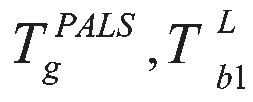ABSTRACT We report on the dynamical behavior of spin probe 2,2,6,6 – tetramethyl – 1 - piperidinyloxy (TEMPO) in amorphous van der Waals-type glass-forming polymer poly (isobutylene) (PIB) as measured over a wide temperature range by electron spin resonance spectroscopy (ESR). To reveal the relative influence of physical factors controlling the spin probe dynamics, the reorientation properties of TEMPO were related to the free volume data on PIB as obtained from positron annihilation lifetime spectroscopy (PALS) as well as to the relaxation results on PIB from nuclear magnetic resonance (NMR) and broadband dielectric spectroscopy (BDS). The characteristic ESR temperatures (  , ,  and and  ) determined from the spectral parameter of mobility, ) determined from the spectral parameter of mobility,  , and those ( , and those (  , and , and  ) from the rotational correlation time, ) from the rotational correlation time,  , as a function of temperature, were found to be related to the characteristic PALS temperatures , as a function of temperature, were found to be related to the characteristic PALS temperatures  , and , and  from phenomenological analyses of the temperature dependences of the mean o-Ps lifetime, from phenomenological analyses of the temperature dependences of the mean o-Ps lifetime,  , and the width of the o-Ps lifetime distribution, , and the width of the o-Ps lifetime distribution,  . Further, the close relationships between the spin probe size . Further, the close relationships between the spin probe size  and the free volume hole size distributions and the free volume hole size distributions  at at  = = and and  point towards the role of free volume in the slow to rapid regime transition or in the crossover within the rapid regime, respectively. Moreover, closeness of point towards the role of free volume in the slow to rapid regime transition or in the crossover within the rapid regime, respectively. Moreover, closeness of  and and  with with  as well as of as well as of  with with  indicate the common origin of the underlying processes. The origin of these ESR and PALS coincidences can be traced out towards the secondary indicate the common origin of the underlying processes. The origin of these ESR and PALS coincidences can be traced out towards the secondary  and and  processes as detected by nuclear magnetic resonance or broadband dielectric spectroscopy, respectively. processes as detected by nuclear magnetic resonance or broadband dielectric spectroscopy, respectively.
Buy this Article
|

